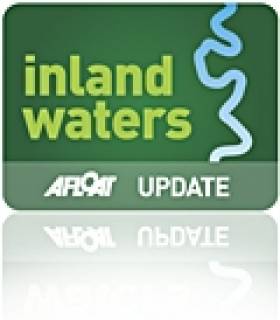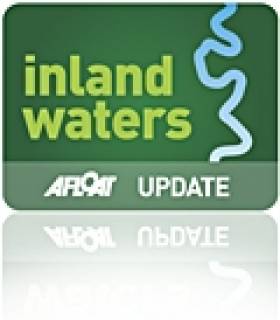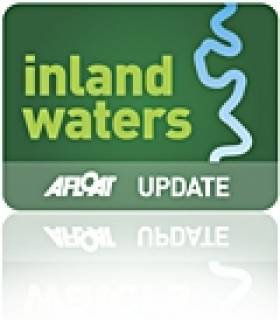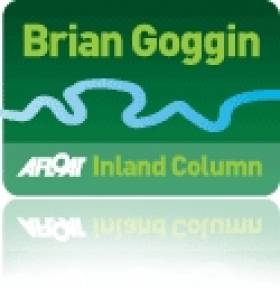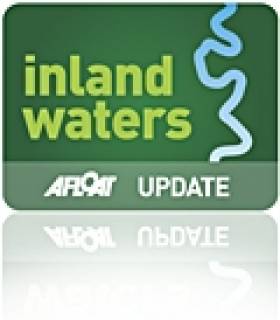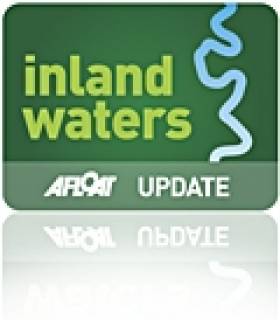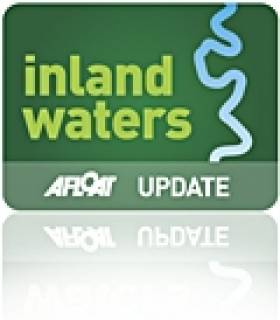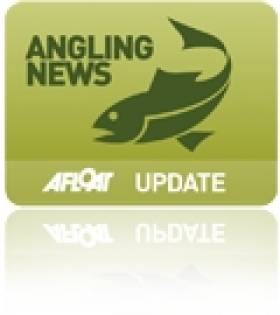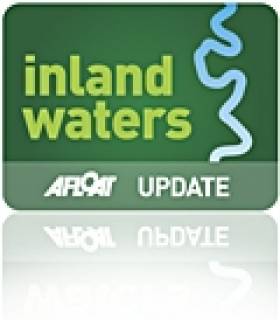Displaying items by tag: Grand Canal
#grandcanal – Waterways Ireland advises that the closure of the Grand Canal from the Kilbeggan Bridge to Coxes Bridge has been extended from 15th March until 27th March 2013 in order to facilitate completion of works. This information is from Marine Notice No. 136 of 2012 and No. 10 of 2013.
Grand Canal Restrictions in Tullamore Extended
#InlandWaterways - Waterways Ireland advises masters and owners of vessels that the closure of the Grand Canal from the Kilbeggan Bridge to Cox's Bridge in Tullamore has been extended from 4 March until 15 March 2013.
There will restricted navigation from the 26th Lock to the Kilbeggan Bridge due to reduced water levels of between 300mm and 400mm in this section of the canal.
The closure will facilitate Tullamore Town Council’s construction of three footbridges and a new board walk in the Tullamore area.
Enforcement of Mooring Bye-laws on Grand & Royal Canal & Barrow Navigation
#byelaws – Waterways Ireland will begin enforcement of the mooring Bye-Laws on the Barrow Navigation, Grand Canal and Royal Canal on the 19th March 2013. A Marine Notice will be issued on the 19th March to this effect.
The enforcement process will begin with non-permitted, sunken and abandoned boats already on the system. The first step in the process is notification. Continued non-compliance with the Bye-laws may result in the craft being removed from the navigation and stored at the owners cost.
A one year permit for passage and 5 day mooring costs €126. A year-long mooring permit for a single location costs €152. For boats already on the canal system, both permits must be applied for in advance of the 19th March 2013 and be on display on the boat by the 31st March 2013.
New boats visiting the Grand Canal, Royal Canal or Barrow Navigation for longer than 1 month may apply for the CMP in advance of arrival on the system and must apply for the Extended Mooring Permit as soon as they plan to remain for longer than five days in a single location.
The application process is simple using a form that can be downloaded from www.waterwaysireland.org or sent out by post from Waterways Ireland Tullamore (Tel no 057 9352300).
Waterways Ireland has extended the number of Authorised Officers, who under the Bye-laws have the authority to undertake enforcement.
More information is available from Shane Anderson, Assistant Inspector of Navigation: Tel no +353 (0)87 286 5726, Email [email protected] .
Making Waves On The Canals
There's an old joke about a Scottish hellfire preacher trying to educate his flock about the punishment awaiting them if they do not mend their ways. He tells them that the ungodly will find themselves in the flames of hell, suffering unimaginable torments, and that they will cry to the lord for mercy, saying "Laird, laird, spare us: we didna ken whit torments awaited us." And, he tells them, the lord in his infinite goodness and mercy will gaze down upon them from heaven and he will say unto them "Well, ye ken noo".
WI and the canals
Some folk with boats on the Royal, Grand and Barrow may be feeling a bit like the ungodly at the moment, with the role of the lord being played by Waterways Ireland (WI). It seems that, as predicted here, WI is finally moving to take control of its canals.
Several new initiatives are under way, more are promised, some are predicted — and all in all it probably amounts to the biggest set of changes to boating on the canals since the end of commercial carrying. Furthermore, there are suggestions that the canals are being seen as a pilot study: that some of the changes will be applied to the Shannon and the Erne in years to come.
Cheap boating
Until now, you could keep a boat on the canals for e126 a year. That covered as many miles as you wanted and passage through as many locks as you wanted; it also covered mooring for the year. There is a bye-law that says you must not stay in one place for more than five days at a time, but it was widely ignored and scarcely ever enforced.
So you could, for example, keep your boat near Dublin, perhaps at a location close to a railway station, and live on it all year round. Or you could keep it there in the winter and move to the Shannon end for the summer, basing your boat at Shannon Harbour (Grand Canal), just one or two locks away from the Shannon, or at Richmond Harbour (Royal Canal), just one lock away. The cost was well below that of a Shannon marina berth.
The bye-laws simply did not reflect the ways in which people actually used boats, either as pleasure craft or for living on. And the charges to users were well below the cost of competitors' products (e.g. commercial marinas' charges), well below the charges on UK waterways and, in particular, well below the cost of running the waterways.
Costs to taxpayers
In the year ended 31 December 2010, WI's operating income, excluding "net deferred funding for pensions", was e547,000. That's the total for all waterways, coming from licences (e34,000), property (e210,000), operations (e202,000), interest (e1,000) and other (e100,000). The programme costs (excluding staff and other costs) were:
• Barrow e723,000
• Grand e2,074,000
• Royal e2,873,000
• the rest e2,098,000.
So the Grand, by itself, cost almost as much as the Lower Bann, the Erne, the Shannon and the Shannon–Erne Waterway put together. The Barrow, Grand and Royal accounted for 73% of the costs but for a far lower proportion of the boats and the income.
I don't intend that as a reflection on the efficiency with which the different waterways are operated: canals are entirely different in nature to river and lake navigations, with far more waterways infrastructure, and will cost more to run. But I give the figures for two reasons. First, they show that, if WI wanted to reduce the gap between income and expenditure, it would inevitably focus on the canals. Second, the figures give some idea of the extent of the subsidy being provided by the taxpayer to canal-based boaters: if there are, say, a thousand boats based on the canals and Barrow, each of them is being subsidised by (on average) about e5,500 a year from the taxpayer.
Costs to boaters
I'm always inclined to look at the economic angle, but WI doesn't dwell on it. Nonetheless it will increase the costs to boaters and will also increase WI's income. Instead of a single e126 annual charge, boaters will now pay
• e126 for a Combined Mooring
& Passage Permit
• e152 for an Extended Mooring
Permit (EMP)
• e250 as a damage deposit,
which I presume will be rolled
forward in succeeding years.
Furthermore, boaters applying for Extended Mooring Permits (EMPs) must produce insurance certificates; for anyone currently uninsured, that will be an extra cost, as will any survey and remedial work required.
There will be other extra costs, of which more below, in future years.
Controlling mooring
At the core of WI's current activity is its taking control of the banks. It is marking out lengths that can be allocated to boats; it will allocate those lengths to those applying for EMPs. It does not guarantee that boaters will get their preferred spaces, or that they will get the same space every year. But once a space has been allocated, it is reserved for one boat for the year and cannot be used by another. That probably seems obvious to anyone renting a marina berth but it will be a new practice on the canals.
The EMP system was applied first at Rathangan and Vicarstown on the Barrow Line, between Lock 34 and Griffith Bridge on the Grand and at Confey (Leixlip), 15th Lock and 45th Lock (near Richmond Harbour) on the Royal. The second batch will include places in the Grand Canal Dock in Dublin, at Pike Bridge, near Maynooth, and at Abbeyshrule on the Royal and near Lock 34 on the Royal. There will be more batches through to spring 2013; full details on http://www.waterwaysireland.org; select New Canal Permit System from the menu on the left.
Continuous Cruisers (as they're called in Britain), folk who stay no more than five days in one location, will not be required to have EMPs.
So what happens if a boater doesn't apply for an EMP but doesn't cruise continuously? If I'm reading the bye-laws correctly, WI has the power to remove a boat, store it and, if necessary, sell it, charging the owner for the costs of doing so.
Information or consultation?
There has been some criticism of WI for not holding consultation meetings before beginning to implement its new policy. My own view is that WI was right: such meetings produce more heat than light, with too much attention on minor individual matters and not enough useful comment on the principles. There is much to be said for creating facts on the ground.
But if consultation has been restricted, the flow of information has not. In fact WI has used its website very effectively, setting out its plans, explaining the procedures and providing FAQs with useful, not PR-type, answers. Whoever has been in charge of that exercise deserves to be commended.
Insurance and dry docking
One thing WI has communicated is that there is more to come.
From 2015 Waterways Ireland will be introducing the requirement for boats needing permits and wishing to use the canals to have a current hull survey to provide evidence that the boat is in good condition. [...] Your attention is being drawn to this requirement now to allow you time to prepare for 2015. [...]
The Licensee undertakes to have regular inspections of the gas and electric services of his Boat as required to ensure these are kept in a safe and serviceable condition. [...]
All Boats must carry adequate fire fighting equipment and have same serviced as per the manufacturer's recommendations. [...]
It is not permitted to re-fuel Boats at an extended mooring.
The requirement for insurance will probably mean more boats needing hull surveys; there is an explicit requirement for such surveys from 2015 onwards. That will put extra pressure on the dry docks, where WI has already introduced restrictions on the boats that can use them and the work that can be carried out. There is, in my view, an urgent and growing need for well-capitalised, well-managed boatyards along all our waterways. The requirements also suggest a need for more fuel sellers along the canals; as far as I know the only one is at Lowtown.
The Shannon and the Erne
The new arrangements will mean better management of the canals, safer boats and more income from WI, all desiderata. But the real excitement would come with their extension to the Shannon and the Erne. The legal basis for charging might have to be different, but WI must surely be planning to raise much more money from Shannon and Erne boaters. The current Shannon lock and bridge fees are pathetically small, hardly worth collecting, and they are not paid at all by those who stay on the lakes.
I am writing this before the Republic's budget is published, but I cannot imagine that it will contain good news for WI. I suspect that it will have to raise much more money itself, and that means from charges to various types of users. Robin Evans, chief executive of Canal & River Trust, which runs the former British Waterways navigations in England and Wales, said recently that his organisation gets only 35% of its funding from the State. The Irish Government must look enviously at that figure.
But it must consider the price elasticity of demand for inland boating. Usage, as measured (however imperfectly) by Shannon lock and bridge passages, has been falling over the last ten years. The chart below shows the figures for the first ten months of each year: at time of writing, figures for November and December 2012 were not available.
It may be time to reinvent the Shannon once again.
Notice of Major Works on Grand Canal at Ringsend Basin
#InlandWaterways - Major renovations of Ringsend Basin at the city terminus of the Grand Canal have commenced, with Waterways Ireland advising all masters and users that works are expected to continue until mid May.
Diving operations commenced on 14 January last week. These involve strengthening the quay walls at Charlotte Quay, the replacement of a slipway and installation of stop planks at Camden Lock (Large Sea Lock).
All works will take place from pontoons adjacent to the area of works. Warning markers will be placed as required to advise all users of the basin.
As a result of the planned works, water levels in the basin may fluctuate. Owners and masters of vessels moored on both Charlotte and Hanover Quays are advised to tend their mooring lines as required.
Vessels may be required to move to facilitate works on Charlotte Quay. Advance notice will be given where possible.
Masters are requested to keep vessels clear of all works and comply with instructions from safety craft in the works areas.
RTÉ One Screening 'A Grand Experience' on the Royal Canal Tomorrow Night
#MARITIME ON TV - Be sure to tune in to RTÉ One tomorrow night (Tuesday 16 October) for a special one-off TV documentary following three very different artists on a voyage of inspiration along the Grand Canal.
A Grand Experience, produced by Mixed Bag Media, joins writer Eugene O'Brien, photographer Veronica Nicholson and musician Wayne Brennan on board a historic 68m canal boat from Shannon Harbour to Edenderry in the Midlands.
Offaly County Council arts officer Sinead O'Reilly told the Offaly Express: “Our intention with commissioning this film, was to demonstrate how beautiful the canal in Offaly is and what an inspiration it can be."
The hour-long film is one of a number of projects from A Very Grand Canal, the scheme commissioned under the Per Cent for Art programme by Offaly County Council earlier this year that collects a variety of artistic responses to the Grand Canal. Some of these projects were exhibited during the recent Tall Ships Races Festival in Dublin.
A Grand Experience will be broadcast Tuesday 16 October at 10.15pm on RTÉ One, and will hopefully be available to view online later via the RTÉ Player.
Waterways Ireland Dredging of Grand Canal in Dublin Continues
#grandcanal – Waterways Ireland has confirmed that further dredging of the Dublin inner city section of the Grand Canal will commence in October 2012. This work follows on from previous dredging contracts completed on the Grand Canal between November 2009 and April 2011 from Grand Canal Basin to Lock C7 at Portobello. The work is necessary to keep the Canal navigable for a large range of boats.
To facilitate works the Grand Canal will be closed to navigation from October 2012 to March 2013 between Lock C7 at Portobello on the Circular Line and Lock 2, Davitt Road on the Main Line. The work will be executed under contract by L & M Keating Limited and will involve the use of excavating machinery working within the canal property. The works are due to be completed by end of March 2013.
The work will involve the removal of sediment deposits from the central navigation channel of the canals and the clearance of rubbish. Traffic Management Plans agreed with Dublin City Council, have been designed to keep disruption to a minimum.
Extensive discussions have taken place with National Parks and Wildlife Service on measures to minimise the impact of these essential maintenance works on the sensitive habitats established within the canals. All material removed from the canals will be transported to licensed disposal facilities.
The work is funded by the Government under the National Development Plan 2007 - 2013. For further information on the project please visit the Waterways Ireland web site www.waterwaysireland.org and check out the 'Navigation Information, Planned Works' page.
Grand, Royal Canal & Barrow Navigation Mooring Rules Come into Force
#inland – Waterways Ireland announced in June 2012 that the Canal Bye-laws on the Grand & Royal Canal and Barrow Navigation are to be enforced from autumn 2012, with an accompanying change in the permit system allowing for year-long mooring permits and locations.
Part of bringing in this new location-based permit has been the identification of locations suitable for extended mooring. This process is now completed and work has begun in some areas to improve accessibility.
Waterways Ireland will roll out Extended Mooring Permit applications by area, rather than giving a date when applications for the permit will open. For boat owners this will mean that enforcement of the maximum stay rule will not commence in an area until after boat owners have had the opportunity to purchase an Extended Mooring Permit.
The initial 12 month Extended Mooring Permit will cost €152 and will only be available to boats already holding a valid annual Mooring and Passage Permit.
Boats that cruise and move (staying at a mooring for up to 5 days) will not be in breach of the Bye-laws or require an Extended Mooring Permit.
Waterways Ireland has proposed a small number of draft amendments to the current Bye-laws which date from 1988. These include proposals to provide a range of charges for mooring permits that reflect the location and services provided throughout the canals and also will take into account the size of boat. These proposals include low cost rural moorings on soft banks to ensure the canals are accessible for everyone who owns a boat and requires a mooring. Boat owners allocated an extended mooring location in key areas in villages or towns or with services should be aware that if the new Bye-laws are approved Waterways Ireland will increase the charges for moorings in the future to reflect the location, services, and size of boat.
Waterways Ireland recognises the current situation whereby a small number of boat owners use their boats as their sole or permanent residence. Proposals to make provision for this use of the navigation property have been included in the Bye-law changes.
Furthermore Waterways Ireland intends to work towards the provision of a small number of serviced house boat moorings on the canal network. Such provision will be subject to finance, land availability and compliance with requisite statutory approvals.
Waterways Ireland recognises that a transition period of a number of years will be required to implement this. In the interim these boat owners should apply for an Extended Mooring Permit.
The draft Bye Law amendments are currently being considered by Waterways Ireland's sponsor Departments. When Waterways Ireland has Ministerial consent, it will proceed to public consultation on the proposed Bye-law amendments.
Waterways Ireland will continue to contact permit holders regularly to ensure they are kept up to date with the roll-out of the new permit. All queries about the enforcement of the current bye-laws or the Extended Mooring Permit should be directed to Shane Anderson, Assistant Inspector of Navigation: Tel no +353 (0)87 286 5726, Email [email protected] . Queries about houseboats should be directed to Property & Legal Section Tel no +44 (0)28 6632 3004.
These changes are necessary steps to improve the management of the canals and waterway amenities for both the navigational and recreational user, so that investment in the new infrastructure and facilities which Waterways Ireland has undertaken is maximised for every user.
Grand Canal Bonanza for Wheelchair Anglers
#ANGLING - The Irish Times' angling correspondent Derek Evans was on hand at the Irish Wheelchair Association's eighth annual fishing competition on the banks of the Grand Canal at Lucan recently.
More than 100 anglers from 15 different centres around the country took park in the three-hour event, supported by Inland Fisheries Ireland, Waterways Ireland and Clondalkin-based fishery manager Godfrey Donohue.
The team from Clontarf in north Dublin came out on top after a good afternoon's fishing - perch, pike and trout all showing up to take the bait.
Darren McCabe of the second-placed Navan A team was especially pleased with his performance after a barren 2011 contest, snaring a 500g 'jack' pike, while Navan B team member Brian Melville and Athlone's Pat Feeney both caught wild brown trout.
The Irish Times has more on the story HERE.
#INLAND WATERWAYS - Waterways Ireland has applied for planning permission to build a new houseboat mooring facility on the Grand Canal at Sallins in Co Kildare.
The planned 210-metre fixed timer mooring is expected to cater for 12 boats with electric and water service supply bollards as well as a sewage pumpout.
There will also be 45 metres of short-term mooring space, a 12-space car park and disabled access to the facility.
Submissions on the planning application will be accepted by Kildare County Council till 11 September 2012. Details are available via the council's online planning system (application number 12645).
As previously reported on Afloat.ie, Waterways Ireland launched a scheme earlier this year for renting houseboat berths at the western end of the Grand Canal at Shannon Harbour.





























